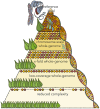Plant pangenomes for crop improvement, biodiversity and evolution
- PMID: 38378816
- PMCID: PMC7616794
- DOI: 10.1038/s41576-024-00691-4
Plant pangenomes for crop improvement, biodiversity and evolution
Abstract
Plant genome sequences catalogue genes and the genetic elements that regulate their expression. Such inventories further research aims as diverse as mapping the molecular basis of trait diversity in domesticated plants or inquiries into the origin of evolutionary innovations in flowering plants millions of years ago. The transformative technological progress of DNA sequencing in the past two decades has enabled researchers to sequence ever more genomes with greater ease. Pangenomes - complete sequences of multiple individuals of a species or higher taxonomic unit - have now entered the geneticists' toolkit. The genomes of crop plants and their wild relatives are being studied with translational applications in breeding in mind. But pangenomes are applicable also in ecological and evolutionary studies, as they help classify and monitor biodiversity across the tree of life, deepen our understanding of how plant species diverged and show how plants adapt to changing environments or new selection pressures exerted by human beings.
© 2024. Springer Nature Limited.
Conflict of interest statement
The authors declare no competing interests.
Figures




References
-
- Gao L, et al. The tomato pan-genome uncovers new genes and a rare allele regulating fruit flavor. Nature Genetics. 2019;51:1044–1051. - PubMed
Publication types
MeSH terms
Grants and funding
LinkOut - more resources
Full Text Sources
Miscellaneous

